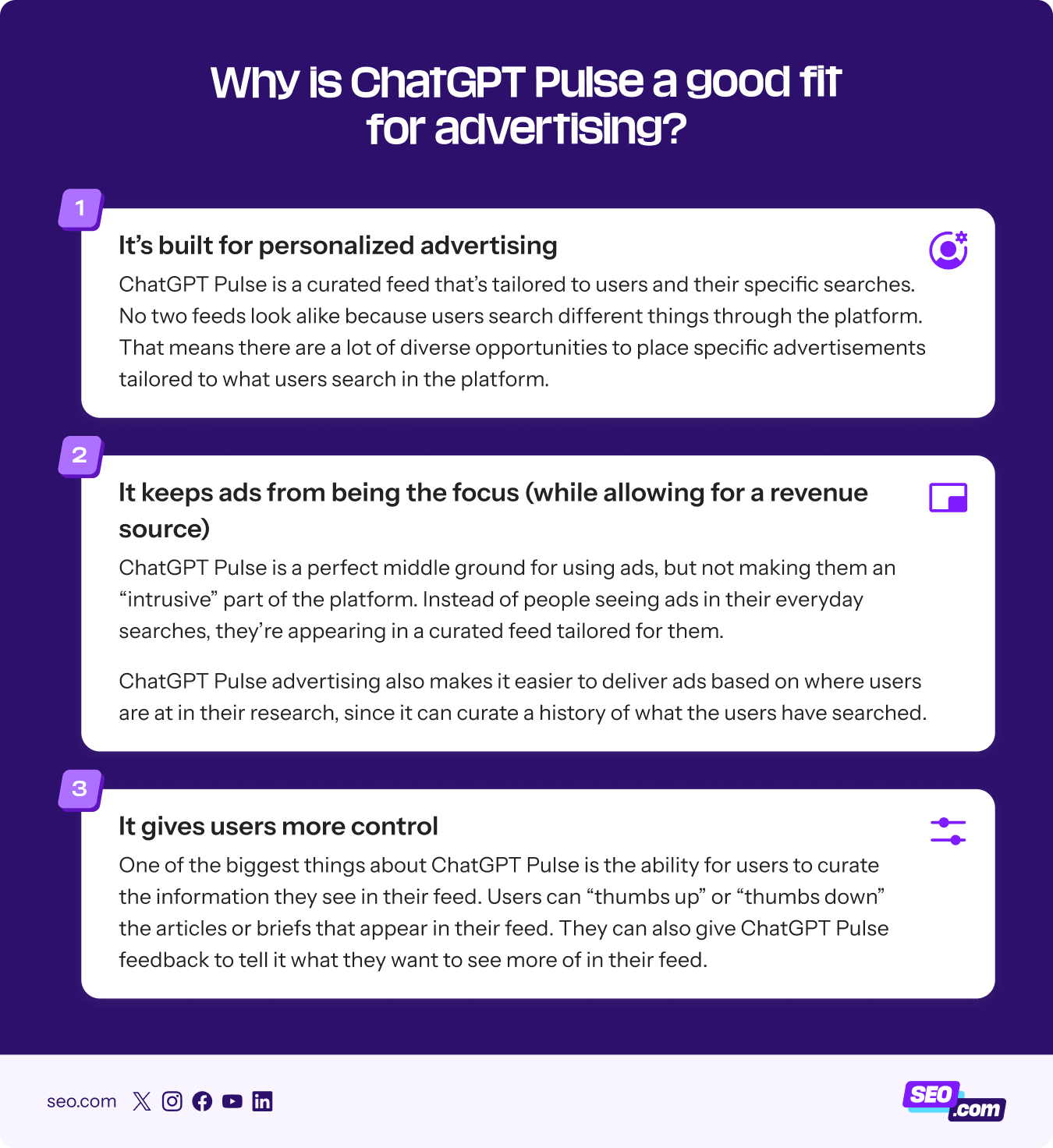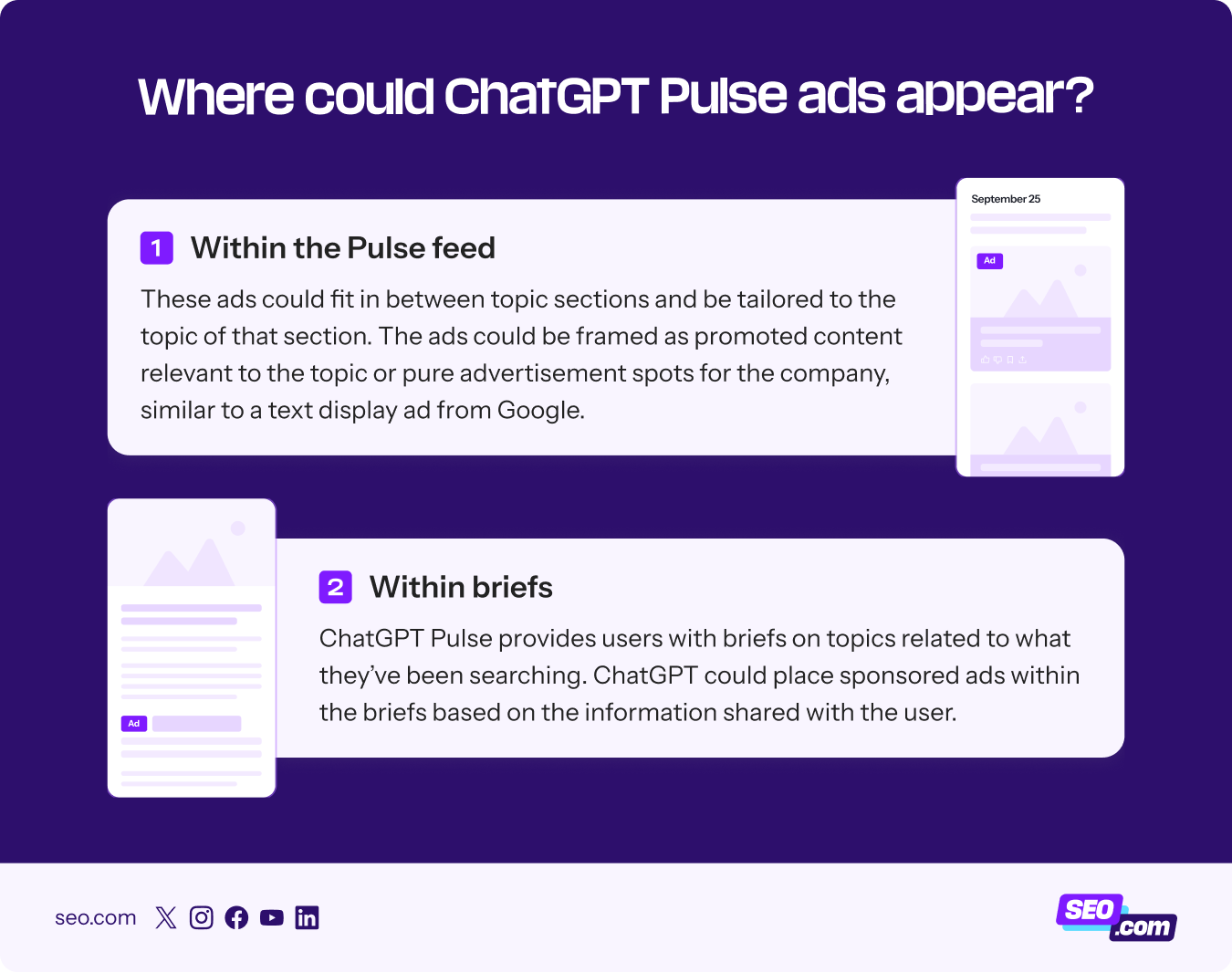ChatGPT just launched ChatGPT Pulse in September 2025 to Pro users, allowing them to be the first to test out this new feature and provide feedback for improving before launching to other users.
The exploration of this personalized, curated feed has people wondering — will ChatGPT Pulse have ads?
Realistically, it very well could. While OpenAI is still sticking to their no ads model, Pulse is primed for delivering personalized ads to users if they want to implement them.
Let’s break down the evidence that indicates it could become the perfect place for ChatGPT to launch ads.
Jump ahead to what you want to see:
- Could ChatGPT Pulse ads happen?
- Why is ChatGPT Pulse a good fit for ads?
- What could ChatGPT Pulse ads look like and where could they appear?
Could ChatGPT Pulse ads be a thing?
Search pros and tech experts have long said that ChatGPT will offer advertising in some capacity. But what has OpenAI said about it?
Advertising on ChatGPT has long been a murky area with OpenAI. CEO Sam Altman insists that ChatGPT advertising is a “last resort,” while CFO Sarah Friar has said that the company “will be thoughtful” about where and when they use ads.
So, advertising isn’t totally out of the realm of possibilities, especially not ChatGPT Pulse advertising.
On top of that, there’s the issue of revenue generation. Currently, OpenAI brings in about $3.5–$4.5 billion in revenue, but they spend over $8.5 billion to run their operations. Based on the current model, many financial analysts don’t think ChatGPT will see a profit until 2029.
So, the question then becomes, can OpenAI survive another few years on their current model?
That’s why questions of ChatGPT Pulse advertising, and advertising in general, have circulated around. It’s the way a lot of search engines turn a profit (just ask Google), which means ChatGPT could soon follow suit.
So, why is ChatGPT Pulse a good fit for advertising?

ChatGPT has multiple opportunity areas where it could advertise. Here are a few reasons why ChatGPT Pulse is one of the better options:
1. ChatGPT Pulse is built for personalized advertising
ChatGPT Pulse advertising is a possibility solely because of the way it’s built.
First, it’s a curated feed that’s tailored to users and their specific searches. No two feeds look alike because users search different things through the platform. Even if two people search a similar subject, they aren’t searching the exact same queries.
One person may see things in their feed about healthy meals, planning a 401k, and landscaping, while another person may see information about healthy meals, the safest cars for families, and yoga tips.
That means there are a lot of diverse opportunities to place specific advertisements tailored to what users search in the platform.
For example, if someone’s searching different types of mortgages, they may see information in their pulse about how to choose a mortgage lender and interest rates, followed by an advertisement from a mortgage broker.
Because these feeds are so curated to the user and how they search, it’s the perfect opportunity to deliver ads related to their searches.
2. ChatGPT Pulse keeps ads from being the focus (while allowing for a revenue source)
As mentioned earlier, Sam Altman is not a big fan of ads. While he’s not against using them, he sees them as more of a last resort for allowing people to continue accessing ChatGPT.
ChatGPT Pulse is a perfect middle ground for using ads, but not making them an “intrusive” part of the platform.
So, instead of people seeing ads in their everyday searches, they’re appearing in a curated feed tailored for them. It allows for ads to still be present in the platform without being front and center. ChatGPT Pulse advertising also makes it easier to deliver ads based on where users are at in their research, since it can curate a history of what the users have searched.
3. ChatGPT Pulse gives users more control
One of the biggest things about ChatGPT Pulse is the ability for users to curate the information they see in their feed. Users can “thumbs up” or “thumbs down” the articles or briefs that appear in their feed. They can also give ChatGPT Pulse feedback to tell it what they want to see more of in their feed.
It’s not unreasonable to think that, because of the way it’s structured, ChatGPT could add ads to Pulse but give users some control over what ads they’re seeing. It could be an appealing model for OpenAI, considering the CEO’s stance on ads.
Since users already have influence over their ChatGPT Pulse feed, this could be a good area of compromise where users can see ads, but provide feedback on those ads to further personalize their feed.
What could ChatGPT Pulse ads look like (and where could they appear)?

Since ChatGPT Pulse ads aren’t launched yet, there’s no surefire answer as to what they could look like or where they could appear in the feed. But, here are two possibilities:
1. Within the Pulse feed
The most obvious place for ChatGPT Pulse ads to appear is within the curated feed. These ads could fit in between topic sections and be tailored to the topic of that section. The ads could be framed as promoted content relevant to the topic or pure advertisement spots for the company, similar to a text display ad from Google.
2. Within briefs
ChatGPT Pulse provides users with briefs on topics related to what they’ve been searching. One area where ads could appear is within these briefs. ChatGPT could place sponsored ads within the briefs based on the information shared with the user.
Stay ahead of the curve with the latest AI SEO updates
Staying on top of what’s happening in the AI SEO world is crucial for staying one step ahead of your competitors. To keep up with the latest AI SEO news, whether it’s ChatGPT launching ads or Google tweaking AI Overviews, subscribe to SEO 2.0 to keep your finger on the pulse!

Keep Up With The Changing Landscape of SEO
Join our newsletter to receive practical tips and expert advice to help you improve your website’s visibility.



Keep Up With The Changing Landscape of SEO
Join our newsletter to receive practical tips and expert advice to help you improve your website’s visibility.

Keep Up With The Changing Landscape of SEO
Join our newsletter to receive practical tips and expert advice to help you improve your website’s visibility.
What to read next
- Nov 06, 2025
- 11 min. read
- Nov 05, 2025
- 9 min. read



